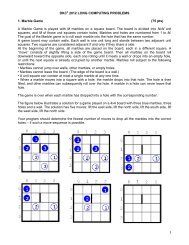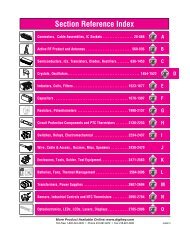Microcontroller Solutions TechZone Magazine, April 2011 - Digikey
Microcontroller Solutions TechZone Magazine, April 2011 - Digikey
Microcontroller Solutions TechZone Magazine, April 2011 - Digikey
Create successful ePaper yourself
Turn your PDF publications into a flip-book with our unique Google optimized e-Paper software.
will make connectivity even easier with simple, yet reliable wireless<br />
connections for even greater convenience. MCUs will need to provide<br />
a variety of integrated connectivity interface methods, such as<br />
integrated USB controllers with precision oscillators.<br />
RF transmitters and transceivers working in concert with MCUs<br />
can enable wireless connectivity for telemedicine applications. In<br />
addition, wireless MCUs – highly integrated devices that combine<br />
a low-power MCU core with a high-performance RF transceiver in<br />
the same package – are now widely available. Silicon Labs’ Si10xx<br />
wireless MCUs, for example, provide the ultra-low-power operation<br />
required by battery-powered portable medical applications, coupled<br />
with extended range and exceptional RF sensitivity enabled by an<br />
integrated sub-GHz transceiver.<br />
Whatever the connectivity method or system architecture used,<br />
communication protocol stacks will require more code space in the<br />
MCU. As a result, more memory in smaller footprint devices will be in<br />
greater demand.<br />
While choices in high-performance, low-power MCUs and<br />
communications options will be important, all medical devices will<br />
need to accurately and consistently measure and some aspect of a<br />
person’s health, be it light (for blood oxygen), conductivity (for blood<br />
glucose), pressure (for blood pressure), or temperature. In the health<br />
care market, there is simply no room for errors in measurement.<br />
Mixed-signal MCUs must give superior analog voltage measurement<br />
results in the presence of noisy digital processor and communications<br />
signals in small spaces. This is one of the most challenging<br />
engineering problems faced by semiconductor suppliers, and such<br />
specifi cations will be scrutinized by product engineers, especially<br />
when faced with low battery voltages for the IC. Measurements must<br />
be low in noise and distortion (good signal-to-noise and distortion<br />
ratios) and highly linear. Analog-to-digital converter (ADC) operation<br />
must be allowed even when the MCU is in operation; the end user<br />
will expect to observe functions during measurement, and it is likely<br />
that the MCU will interpret results in real time. Furthermore, all chip<br />
features should be permitted even at the lowest battery voltages;<br />
what good is the MCU if you cannot make a measurement over the<br />
full battery life In short, MCU suppliers in this market must integrate<br />
accurate analog measurements without compromise.<br />
The next design challenge for the MCU supplier is the demand for<br />
long battery life in the end product. “Portable” generally means that<br />
the device is battery powered. Typically, added features result in<br />
greater power consumption, but developers will not design a portable<br />
medical product that requires end users to use large, heavy batteries<br />
or to change them frequently.<br />
MCUs must support three parts of a low-power strategy: low-power<br />
while in active mode, low-power while in standby mode and reduced<br />
time in an active state. The portable device, and thus the MCU, will<br />
be in an off or lower power state most of the time; however, it will<br />
often maintain some sort of function such as a clock/calendar or<br />
alarm when not in use. While active power consumption is important,<br />
minimizing the time awake is the key to extending battery life. MCU<br />
designers must engineer ways to wake the MCU clock and analog<br />
circuits for fast measurements and then allow the MCU to settle back<br />
to a low-power state. For example, making a voltage measurement<br />
with an ADC requires a voltage reference. Such voltage references<br />
typically require tens of milliseconds to turn on and stabilize before<br />
a measurement can be made. During this time the MCU is on and<br />
draining the battery.<br />
Silicon Labs’ ultra-low-power C8051F9xx MCUs (Figure 2) wake up<br />
in microseconds like many power-effi cient MCUs, but the on-chip<br />
voltage reference is designed to also wake within 2 microseconds,<br />
allowing accurate ADC measurements to begin quickly. The ADC is<br />
also designed to rapidly accumulate many measurements without<br />
CPU intervention for improved results while further minimizing time<br />
awake. The less time awake, the less current is drawn from the<br />
battery while giving good results.<br />
Figure 2: Fast wake times and short operation intervals will extend battery life.<br />
Another important trend in MCU design involves supporting new<br />
battery use confi gurations and technologies (Figure 3). Rechargeable<br />
batteries are popular and typically need higher voltage support, so<br />
integrated on-chip voltage regulators are mandatory. An emerging<br />
trend is to use only one alkaline battery to reduce product size or to<br />
save cost when the end user expects the supplier to ship an installed<br />
battery. Until recently, this approach required the added cost and<br />
space of a discrete DC-DC switching regulator to boost the alkaline<br />
battery voltage for proper MCU operation (alkaline batteries have a<br />
useful life to 0.9 V). Not only do these switching regulators create a<br />
large amount of noise in voltage measurements, they must remain<br />
on at all times to allow the MCU to wake from sleep mode, thereby<br />
draining power and reducing battery life.<br />
Sophisticated low-power MCUs such as Silicon Labs F9xx devices include<br />
an integrated DC-DC regulator that addresses these issues. The result is<br />
lower noise, less cost, reduced footprint, and better control, allowing the<br />
DC-DC regulator to be off while the MCU is in its low-power state, thus<br />
extending battery life. Even though this DC-DC regulator is integrated, it<br />
should still output the boosted voltage supply externally to the rest of the<br />
system for a true low-power, single-battery solution.<br />
Figure 3: MCUs should support a wide range of voltages supplied by batteries.<br />
62














